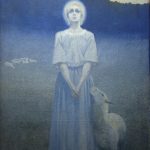Eugène Carrière, a French Symbolist painter, was born on January 16, 1849, in Gournay-sur-Marne, France. Carrière’s artistic career unfolded during the late 19th and early 20th centuries, a period marked by profound social and cultural changes. As a prominent figure in the Symbolist movement, Carrière’s works are known for their introspective and enigmatic qualities, often exploring themes of introspection, the human condition, and spirituality.
Carrière’s early life was marked by financial struggles, and he initially worked as an illustrator and caricaturist to support himself. His artistic pursuits led him to Paris, where he studied at the École des Beaux-Arts under Alexandre Cabanel. Despite his academic training, Carrière’s style would eventually evolve beyond the confines of academic conventions.
The Symbolist movement, with its emphasis on conveying emotions, ideas, and spiritual concepts through suggestive and evocative imagery, strongly influenced Carrière’s artistic direction. He developed a distinctive technique using muted colors, subtle tonalities, and soft transitions, creating an ethereal and dreamlike atmosphere in his paintings.
One of Carrière’s defining features was his frequent use of the chiaroscuro technique, which involved playing with light and shadow to create a sense of depth and mystery. This technique became a hallmark of his Symbolist aesthetic, emphasizing the psychological and emotional dimensions of his subjects.
Carrière’s portraits, particularly those of women and children, are renowned for their emotional depth and psychological insight. His works often conveyed a sense of quiet introspection, inviting viewers to contemplate the inner worlds of his subjects. The soft, glowing light in paintings like “Maternité” (1890) and “Woman with a Child” (1894) exemplified his ability to infuse ordinary scenes with a profound sense of emotion and meaning.
Beyond portraiture, Carrière explored allegorical and religious themes. His interest in spiritual and mystical subjects was reflected in paintings like “The Good Samaritan” (c. 1896) and “The Dance of the Muses” (1897), where he employed his signature chiaroscuro technique to convey a sense of otherworldliness.
Carrière’s commitment to exploring the human psyche extended to his fascination with death and the afterlife. Paintings such as “The White and the Black Spirits” (1890) and “The Resurrection” (1899) delved into themes of mortality, spiritual transcendence, and the mysteries of existence.
The artist’s contributions to Symbolism went beyond painting; he also illustrated literary works and collaborated with writers like Maurice Maeterlinck. Carrière’s illustrations for Maeterlinck’s play “Pelléas et Mélisande” (1892) exemplified his ability to visually interpret complex and symbolic narratives.
Despite his association with Symbolism, Carrière’s art transcended easy categorization. His versatility was evident in his exploration of different mediums, including printmaking and pastels. His later works featured more experimental techniques, incorporating elements of abstraction and expressionism.
Eugène Carrière’s influence extended beyond his artistic output; he played a key role in fostering artistic community and was associated with influential figures of his time, including Auguste Rodin and Edgar Degas. His dedication to exploring the inner dimensions of human experience left an indelible mark on the Symbolist movement.
Eugène Carrière passed away on March 27, 1906, leaving behind a body of work that continues to be appreciated for its introspective depth, technical innovation, and its contribution to the rich tapestry of Symbolist art. His legacy endures, and his paintings are featured in major art institutions, serving as timeless expressions of the mysteries of the human soul.






